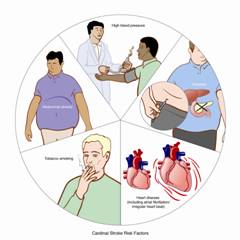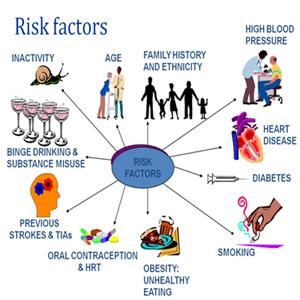Stroke risk factors:
What risk factors for stroke can't be changed?
Age — The chance of having a stroke approximately doubles for each decade of life after age 55. While stroke is common among the elderly, a lot of people under 65 also have strokes. Nowadays due to lifestyle factors, more young adults aged 30-50 years suffered from stroke.
Heredity (family history) — Your stroke risk is greater if a parent, grandparent, sister or brother has had a stroke. The familial trend correlates with that of hypertension, hypercholesterolemia and diabetes mellitus.
Sex (gender) — Stroke is more common in men than in women. In most age groups, more men than women will have a stroke in a given year. However, use of birth control pills and pregnancy pose special risks to female stroke patients, thus more than half of total stroke deaths occur in women. Hence at all ages, more women than men die of stroke.
Prior stroke, TIA or heart attack — The risk of stroke for someone who has already had one is many times that of a person who has not. If you've had a heart attack, you're at higher risk of having a stroke, too.

What stroke risk factors can be changed treated or controlled?

Poor diet — Diets high in saturated fat, trans fat and cholesterol can raise blood cholesterol levels. Diets high in sodium (salt) can contribute to increased blood pressure. Diets with excess calories can contribute to obesity. Also, a diet containing five or more servings of fruits and vegetables per day may reduce the risk of stroke.
Physical inactivity and obesity — Being inactive, obese or both can increase your risk of high blood pressure, high blood cholesterol, diabetes, heart disease and stroke. Try to get a total of at least 30 minutes of activity on most or all days.
Regular resting time & sleep---In our clinical experience, recent illness, inadequate rest and sleeping pattern trigger stroke attack in patients who are already stroke prone by their preexisting risk factors.
Cigarette smoking (active and passive)— In recent years, studies have shown cigarette smoking to be an important risk factor for stroke. The nicotine and carbon monoxide in cigarette smoke damage the cardiovascular system in many ways.
Drugs---The use of oral contraceptives combined with cigarette smoking greatly increases stroke risk. Soft drugs abuse also impose risk of having a stroke.
Alcohol abuse — Alcohol abuse can lead to multiple medical complications, including stroke. Excessive alcohol consumption can cause stroke. For those who consume alcohol, a recommendation of no more than two drinks per day for men and no more than one drink per day for non-pregnant women best reflects the state of the science for alcohol and stroke risk.

High blood pressure — High blood pressure is the leading cause of stroke (accounts for 35-50% of stroke risk) and the most important controllable risk factor for stroke. Many people believe that effective treatment of high blood pressure is a key reason for the accelerated decline in the death rates for stroke. However in some special clinical conditions i.e. in patients with pre-existing of vascular stenosis e.g. Carotid artery stenosis, a slightly higher blood pressure level are needed to be tailored-made by a stroke neurosurgeon.
High blood cholesterol — High blood cholesterol cause atherosclerosis and thus increased the risk for stroke. It appears that low HDL ("good") cholesterol is a risk factor for stroke in men, but more data are needed to verify its effect in women. Lipid lowering drugs have been shown to reduce the risk of stroke by about 15%
Diabetes mellitus — Diabetes carries familial trend and is an independent risk factor for stroke. Diabetes mellitus increases the risk of stroke by 2 to 3 times. Many people with diabetes also have high blood pressure, high blood cholesterol and are overweight. This increases their risk even more.
Carotid or intracranial artery disease — The carotid arteries in your neck supply blood to your brain. Carotid artery stenosis is a disease caused by atherosclerosis fatty deposits forming a plaque to narrow the lumen of the artery. The blood flow to supply brain was thus jeopardized; it may or may not cause symptoms to patient. Sometimes small fatty deposits at arterial wall may dislodge, flow distally and block the brain vessels and cause embolic stroke. Sometimes the disease also made the carotid artery being prone to injury (arterial dissection injury) or prone to be blocked by a blood clot, thus leading to major stroke. When the artery disease happens at arteries inside the brain i.e. intracranial artery stenosis, it will also cause stroke in a similar manner.
Peripheral artery disease — This is the narrowing of blood vessels carrying blood to limbs and organs. It's caused by fatty buildups of plaque in artery walls. People with peripheral artery disease have a higher risk of carotid artery disease or intracranial vessels disease, which raises their risk of stroke.
Atrial fibrillation — Being common in elderly, this heart rhythm disorder raises the risk for stroke. The heart's upper chambers quiver instead of beating effectively, which can let the blood pool and clot. If a clot breaks off, enters the bloodstream and lodges in an artery leading to the brain, a stroke results. Those with atrial fibrillation have a 5% a year risk of stroke, and this risk is higher in those with valvular atrial fibrillation. [Depending on the stroke risk, anticoagulation or anti-platelet drugs is warranted for stroke prevention
Other heart disease — People with some types of congenital heart defects, heart valve disease, coronary heart disease, dilated cardiomyopathy (an enlarged heart), heart failure have a higher risk of stroke than those with hearts that work normally.





